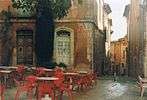Roussillon, Vaucluse
| Roussillon | ||
|---|---|---|
|
A view of the village of Roussillon | ||
| ||
 Roussillon | ||
|
Location within Provence-A.-C.d'A. region  Roussillon | ||
| Coordinates: 43°54′11″N 5°17′37″E / 43.9031°N 5.2936°ECoordinates: 43°54′11″N 5°17′37″E / 43.9031°N 5.2936°E | ||
| Country | France | |
| Region | Provence-Alpes-Côte d'Azur | |
| Department | Vaucluse | |
| Arrondissement | Apt | |
| Canton | Gordes | |
| Intercommunality | Communauté de communes du Pont Julien | |
| Government | ||
| • Mayor (2008–2014) | Gisèle Bonnelly | |
| Area1 | 29.77 km2 (11.49 sq mi) | |
| Population (2008)2 | 1,291 | |
| • Density | 43/km2 (110/sq mi) | |
| Time zone | CET (UTC+1) | |
| • Summer (DST) | CEST (UTC+2) | |
| INSEE/Postal code | 84102 / 84220 | |
| Elevation |
159–365 m (522–1,198 ft) (avg. 343 m or 1,125 ft) | |
|
1 French Land Register data, which excludes lakes, ponds, glaciers > 1 km² (0.386 sq mi or 247 acres) and river estuaries. 2 Population without double counting: residents of multiple communes (e.g., students and military personnel) only counted once. | ||
Roussillon is a commune in the Vaucluse department in the Provence-Alpes-Côte d'Azur region in southeastern France.
Roussillon lies within the borders of the Parc Naturel Régional du Luberon. In the French natural regional parks, new economic activities may be developed only if they are sustainable.[1]
It is noted for its large ochre deposits found in the clay surrounding the village. Ochres are pigments ranging from yellow and orange to red. One of the former ochre quarries can be visited via the "Sentier des Ocres" (Ochre Path), a walk of either 30 or 60 minutes through the old workings.
Geography
The village stands on an ochre ridge, situated in a broad valley with the "Monts du Vaucluse" to the north and the "Petit" Luberon to the south. The nearest railway station is in Cavaillon; the nearest TGV station is in Avignon.
The river Calavon forms part of the commune's southern border.
Geology
Roussillon is famous for the rich deposits of ochre pigments found in the clay near the village. The large quarries of Roussillon were mined from the end of the 18th century until 1930. Thousands of people found work in the quarries and factories. Nowadays the mining of ochre is prohibited here, in order to protect the sites from degradation or even complete destruction.
Mining ochre
Because during the 18th century the demand rose for pigments to be used in the textile industry, the mining of ochres in Roussillon intensified. Numerous quarries and ochre factories, some of which can still be seen today, were situated near the village. One example of an ochre factory, the "Usine Mathieu", is named for the family that owned it from 1870 to 1901. It has been formed into a "Conservatoire": a workshop serving as a museum. The quarries and factories were established in the villages of Roussillon, Villars, Gargas, Rustrel (with its Colorado provençal) and Gignac.
During the 20th century, mining techniques were modernized, which meant that more profitable ochre mines became exploitable. This resulted in a gradual closing-down of ochre mines in and around Roussillon. From the 1980s, tourism has replaced ochre industry as a source of income.[2]
Agriculture
Apart from tourism, agriculture is the commune's principal activity. Fruit, including cherries, peaches and melons are grown. Much of this is used in crystallized fruit production in nearby Apt. Wine-making is very important and there are several wineries producing red, rosé, and white wines within the Ventoux AOC.
Literary and other cultural references
The writer Samuel Beckett went into hiding from the Germans in Roussillon during the years 1942–1945. His novel Watt was written there, and Beckett mentioned the village in his famous theatreplay Waiting for Godot (En attendant Godot) (1955).
Film director Henri Colpi shot this movie Heureux qui comme Ulysse (1970) with Fernandel as the leading character in Roussillon; George Brassens wrote a chanson for the film.
Under the name of Peyrane, Roussillon is the subject of Laurence Wylie, Village in the Vaucluse (first edition 1957.)
Roussillon is the setting of Susan Vreeland's 2015 novel, Lisette's List, about a young couple who move from Paris to Roussillon in 1937 to live with the husband's aging grandfather, an ochre miner and pigment salesman, who owns several post-impressionist paintings.
The village gave its name to a Michelin-starred restaurant in London.[3]
 Roussillon in 1993
Roussillon in 1993 The Church of Roussillon
The Church of Roussillon Mont Ventoux seen from Roussillon
Mont Ventoux seen from Roussillon Ochre rocks in Roussillon
Ochre rocks in Roussillon
Demography
| Year | 1962 | 1968 | 1975 | 1982 | 1990 | 1999 | 2006 |
|---|---|---|---|---|---|---|---|
| Population | 702 | 827 | 1093 | 1313 | 1165 | 1161 | 1265 |
| From the year 1962 on: No double counting—residents of multiple communes (e.g. students and military personnel) are counted only once. | |||||||
See also
References
- ↑ "Charter of the Luberon Parc". Retrieved 14 February 2009.
- ↑ Pagina over de geschiedenis van Roussillon
- ↑ Robinson, Jancis (29 October 2004). "Roussillon – an unfairly overlooked London restaurant". Retrieved 8 May 2011.
- ↑ Municipal Population on 1 January 2006, accessed 19 February 2009
External links
| Wikimedia Commons has media related to Roussillon, Vaucluse. |
- Tourist office website
- Roussillon on Mapquest
- Website of the Parc naturel régional du Luberon
- Conservatoire des Ocres
.svg.png)
